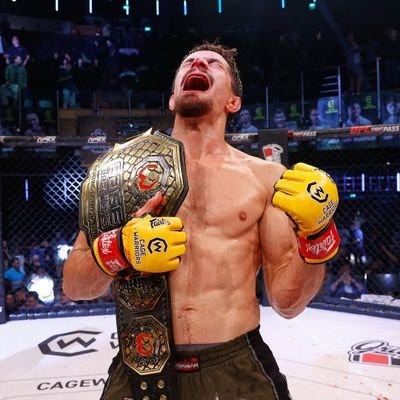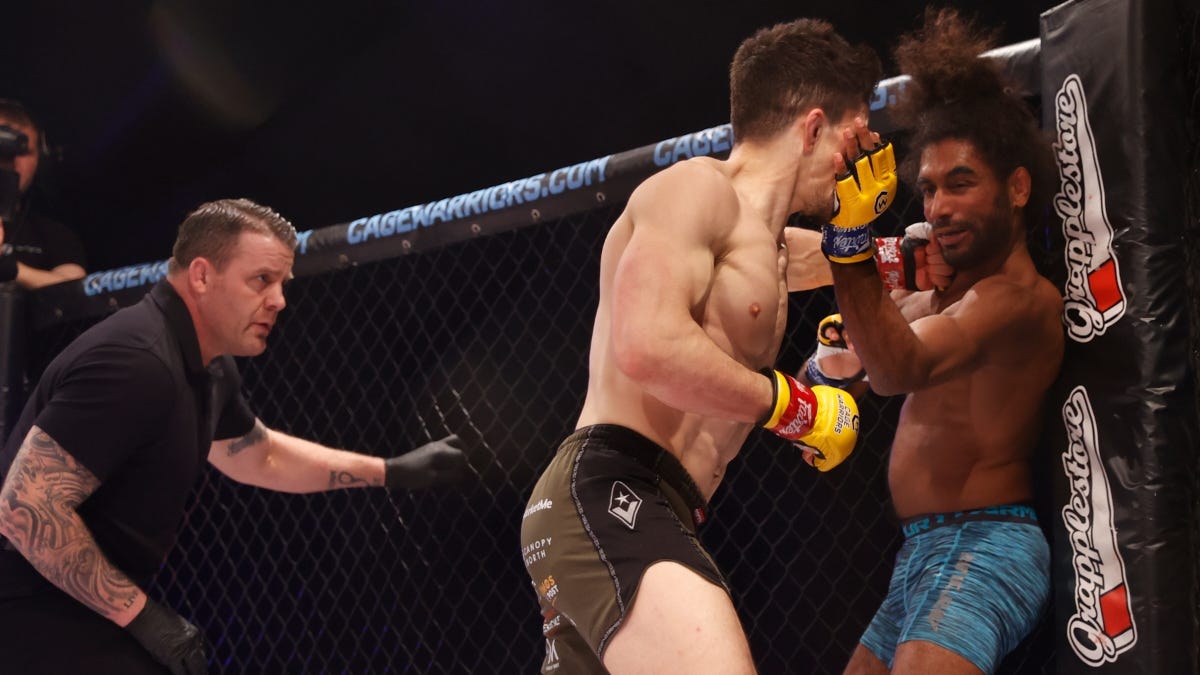How to MMA: Body Punching with George Hardwick
Welcome to the UFC, Body-Snatcher
George Hardwick should not be fighting in Dana White’s Contender Series. He should be fighting at the next London card IN the UFC. If you have not heard of Mr. Hardwick, then let me enlighten you.
George Hardwick is an English fighter who has been fighting professionally in Cage Warriors (and occasionally Bellator) since 2019. He is the current Cage Warriors Lightweight Champion, winning the title in 2022. Cage Warriors is often seen as a European feeder league for the UFC but has been filled with talents such as Conor McGregor, Bigfoot Silva, Michael Bisping, Dan Hardy, Mads Burnell, Molly McCann, and Paddy Pimblett.
Hardwick is a GREAT fighter in his own right and someone on his way to stardom given his aggression, finishing ability, and sense of humour (thats right British spelling).
He is a pressure fighter who favors calf kicks and teeps from the outside, a constant jab, an active high guard, and the subject of today’s article; schooled and varied body punching.
Disclaimer: The video clips included in this article are not owned by the author. They are included for educational purposes only to illustrate key moments in the fighter’s career and demonstrate aspects of mixed martial arts techniques and strategies. All rights to the video content belong to their respective owners.
Hardwick has 3 main weapons in his body punching game:
High Guard + Feints: The Set-up
The Straight to the Body: The Pressure
The Body Hook: The Finish
High Guard + Feints: The Set-Up
Hardwick’s high guard is a staple of his game. It ensures that he gets hit quite often (his face bleeds in just about every recent fight), but it prevents shots from doing full damage even though he is constantly moving forward.
Here is a more open variation similar to Dustin Poirer’s “Hillbilly Shell” where he puts the elbows up to intercept the punches. The elbow is great because you’ll likely block the punch with the meat of your arm, but if their fist hits the elbow they are in for a bad time.
The real genius in the high guard is that it INVITES a return from his opponent. As of late, most of Hardwick’s opponents seem entranced with trying to hit him straight, and right on his guard. Like many high guard users, Hardwick gives himself spots to see through the guard, and knows that when his opponent hits it, they are not defending. This becomes the PERFECT opportunity to sneak a thudding hook to the body in the middle of an exchange. Essentially, Hardwick takes a few damage points in order to dish out one punch worth 10-15.
Hardwick steps with his head forward of his hips and a traditional double-forearms guard. On his opponent’s first return he raises the elbows to intercept the punches. As the opponent extends the combination he takes advantage of his opponent throwing the strike by ripping him to the body.
Hardwick utilizes his active high guard to barrel through his opponent’s strikes in order to get him to the cage to work his own offense and punish the lateral movement
Hardwick secures the finish with pressure. While his opponent unloads on Hardwick’s high guard, he waits for him to commit to the attack and perfectly slips in a body shot that leads to the finish.
A prolific body puncher with 3 body punch finishes on his record, Hardwick has heavy hands that will hurt no matter where he throws them (evidenced in his last performance). As such, he sets a precedent early on that his punches to the body and head will hurt, so the opponent will react to them.
Once Hardwick has let the opponent know that damage is imminent, he can now feint to great effect. Feinting, as it is, is useless without the actual threat of the strike established. This is why you will see great feinters like Volkanovski stay active throughout the first round in order to set the precedent of a threat, and then utilize a more even mixture of feints and committed strikes as the fight goes on.
Hardwick pressures forward, feinting kicks with his hips, small level changes, and hooks, eventually dipping under a return from his opponent and hitting the body.
Hardwick’s bouncing left hand is enough to get his opponent to paw the potential jab. Once he commits to parrying the jab Hardwick is able to slip a left hook to the head in.
After brutalizing him with a couple of left hooks earlier, Hardwick has Bungard biting on all of his feints to the body and head. Hardwick is controlling the pace and already has Bungard to the fence.
Straight to the Body: The Pressure
Hardwick favors his jab and the calf kick when on the outside. His primary objective though is to move in and put his opponent’s back against the cage. His weapon of choice?
The Rear Hand Straight to the body.
I say rear hand as even though he favors the orthodox stance, he does switch stances frequently enough in moments where both have been effective weapons to counter his opponent’s actions.
Yet another instance of Hardwick using the right straight to push the opponent against the fence.
But what makes the rear straight to the body a pressuring tool? The defensive response for almost all MMA fighters is simply to move back after being hit.
Bungard concedes a lot of space simply by retreating once the left straight to the body comes.
Rather than waste energy on a glancing head shot to move them back, Hardwick opts for a longer, attritive weapon that takes more out of his opponent. Winning the war of attrition on the outside and moving his opponent towards the fence wall, Hardwick “puts money in the bank” (as Teddy Atlas says) to tire his opponent over time while simultaneously bringing the fight closer to his desired geography.
Perfect way to cap off the pressure.
Body Hooks: The Finish
Once Hardwick has an opponent up against the fence, they have little option. They can move laterally, but that will often lead them towards a left hook to the body as they circle away from Hardwick’s right hand.
Hardwick often waits to unload with a hard hook to the body until the opponent is against the cage. As said above, they often circle themselves into the strike when trying to circle off the cage. The added benefit is that when their back is against the cage, they can’t move backwards to evade the strike. One way or another, its going to land on something.
Hardwick’s opponent only has two movement options: Right or Left. Moving out to his right only opens him up to the left body hook.
In this sequence, Bungard attempts to hide behind his shoulder to block Hardwick’s right hand. This opens him up to Hardwick’s left to the body. His retreat across the cage makes him a sucker for the left hook to the head afterwards. You can see Bungard blocking the body, Hardwick’s switch ups worked a charm.
They can shell up and attempt to return with a counter as well. Hardwick might get hit, but his chin is made of iron and he has an active high guard himself. Hardwick throws soft and feints to the head to get them to shell up, and then DIGS into their body with a left hook.
Hardwick threw a jab upper and to draw out parries from his opponent as his back was to the cage. This brought his
Doubles up on the right straight to the body, backing his opponent up, and then finishes the combination with a crisp body hook. His opponent is then on the cage where he can keep up the pressure.
This is why he has 3 wins by body shot in Cage Warriors. He doesn’t throw to the body with abandon. His high guard keeps him safe while pressuring and invites strikes from an opponent, corralling them towards the cage. He is able to set it up hard shots to the body by establishing threats in the fight early on, and leveraging the threats with feints.
Body work is an ESSENTIAL weapon in MMA today that not nearly enough fighters use. Hardwick is one of the few who can consistently find finish with body work, but it also opens up opportunities to the head (which Hardwick also exploits). Where everyone else is headhunting, hit the body. Most people are too focused on defending their head as is, so the body is open to hit a clean shot.
George Hardwick is a great fighter who can thrive in the UFC. Similar in some ways to Jack Della Maddalena in the division above, he can quickly make himself a star. Though in one of the deepest divisions in the sport, I hope to see him thrive. Good luck King George, I’ll be rooting for you.
P.S. He’s also got a hilarious YouTube channel you should check out. Goes pretty in depth on technique, training, and fight breakdowns (his own included); something I wish more fighters would do. Do check it out, he’s a cool dude.





